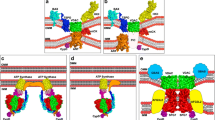Abstract
Minocycline (an anti-inflammatory drug approved by the FDA) has been reported to be effective in mouse models of amyotrophic lateral sclerosis and Huntington disease. It has been suggested that the beneficial effects of minocycline are related to its ability to influence mitochondrial functioning. We tested the hypothesis that minocycline directly inhibits the Ca2+-induced permeability transition in rat liver mitochondria. Our data show that minocycline does not directly inhibit the mitochondrial permeability transition. However, minocycline has multiple effects on mitochondrial functioning. First, this drug chelates Ca2+ ions. Secondly, minocycline, in a Ca2+-dependent manner, binds to mitochondrial membranes. Thirdly, minocycline decreases the proton-motive force by forming ion channels in the inner mitochondrial membrane. Channel formation was confirmed with two bilayer lipid membrane models. We show that minocycline, in the presence of Ca2+, induces selective permeability for small ions. We suggest that the beneficial action of minocycline is related to the Ca2+-dependent partial uncoupling of mitochondria, which indirectly prevents induction of the mitochondrial permeability transition.
Similar content being viewed by others
References
Castanares M, Vera Y, Erkkila K, Kyttanen S, Lue Y, Dunkel L, Wang C, Swerdloff RS, Hikim AP (2005) Biochem Biophys Res Commun 337:663–669
Chen Y, Schindler M, Simon SM (1999) J Biol Chem 274:18364–18373
Chu HC, Lin YL, Sytwu HK, Lin SH, Liao CL, Chao YC (2005) Br J Pharmacol 144:275–282
Cornet S, Spinnewyn B, Delaflotte S, Charnet C, Roubert V, Favre C, Hider H, Chabrier PE, Auguet M (2004) Eur J Pharmacol 505:111–119
Feigin AM, Aronov EV, Teeter JH, Brand JG (1995) Biochim Biophys Acta 1234:43–51
Fernandez-Gomez FJ, Gomez-Lazaro M, Pastor D, Calvo S, Aguirre N, Galindo MF, Jordán J (2005a) Neurobiol Dis 20:384–391
Fernandez-Gomez FJ, Galindo MF, Gomez-Lazaro M, González-García C, Ceña V, Aguirre N, Jordán J (2005b) Neuroscience 133:959–967
Gunter TE, Pfeiffer DR (1990) Am J Physiol 258:C755–786
Halestrap AP, Woodfield KY, Connern CP (1997) J Biol Chem 272:3346–3354
Krasnikov BF, Zorov DB, Antonenko YN, Zaspa AA, Kulikov IV, Kristal BS, Cooper AJL, Brown AM (2005) Biochim Biophys Acta 1708:375–392
Kupsch K, Hertel S, Kreutzmann P, Wolf G, Wallesch CW, Siemen D, Schönfeld P (2009) FEBS J 276:1729–1738
Lin Q, Katakura K, Suzuki M (2002) FEBS Lett 515:71–74
Mansson R, Hansson MJ, Morota S, Uchino H, Ekdahl CT, Elmer E (2007) Neurobiol Dis 25:198–205
Matlib MA, Zhou Z, Knight S, Ahmed S, Choi KM, Krause-Bauer J, Phillips R, Altschuld R, Katsube Y, Sperelakis N, Bers DM (1998) J Biol Chem 273:10223–10231
Matsuki S, Iuchi Y, Ikeda Y, Sasagawa I, Tomita Y, Fujii J (2003) Biochem Biophys Res Commun 312:843–849
Mueller P, Rudin DO, Tien HT, Wescott WC (1963) J Phys Chem 67:534–535
O’Brodovich H, Wang X, Li C, Rafii B, Correa J, Bear C (1993) Am J Physiol 264:C1532–1537
Petronilli V, Cola C, Bernardi P (1993) J Biol Chem 268:1011–1016
Sapadin AN, Fleischmajer R (2006) J Am Acad Dermatol 54:258–265
Scarabelli TM, Stephanou A, Pasini E, Gitti G, Townsend P, Lawrence K, Chen-Scarabelli C, Saravolatz L, Latchman D, Knight R, Gardin J (2004) J Am Coll Cardiol 43:865–874
Scott ID, Akerman KE, Nicholls DG (1980) Biochem J 192:873–880
Sipos EP, Tamargo RJ, Weingart JD, Brem H (1994) Ann NY Acad Sci 732:263–272
Smith DL, Woodman B, Mahal A, Sathasivam K, Ghazi-Noori S, Lowden PA, Bates GP, Hockly E (2003) Ann Neurol 54:186–196
Teng YD, Choi H, Onario RC, Zhu S, Desilets FC, Lan S, Woodard EJ, Snyder EY, Eichler ME, Friedlander RM (2004) Proc Natl Acad Sci USA 101:3071–3076
Wang X, Zhu S, Drozda M, Zhang W, Stavrovskaya IG, Cattaneo E, Ferrante RJ, Kristal BS, Friedlander RM (2003) Proc Natl Acad Sci USA 100:10483–10487
Wang J, Wei Q, Wang CY, Hill WD, Hess DC, Dong Z (2004) J Biol Chem 279:19948–19954
White JR, Pearce FL (1982) Biochemistry 21:6309–6312
Yang L, Harroun TA, Weiss TM, Ding L, Huang HW (2001) Biophys J 81:1475–1485
Zhu S, Stavrovskaya IG, Drozda M, Kim BY, Ona V, Li M, Sarang S, Liu AS, Hartley DM, Wu DC, Gullans S, Ferrante RJ, Przedborski S, Kristal BS, Friedlander RM (2002) Nature 417:74–78
Author information
Authors and Affiliations
Corresponding author
Rights and permissions
About this article
Cite this article
Antonenko, Y.N., Rokitskaya, T.I., Cooper, A.J.L. et al. Minocycline chelates Ca2+, binds to membranes, and depolarizes mitochondria by formation of Ca2+-dependent ion channels. J Bioenerg Biomembr 42, 151–163 (2010). https://doi.org/10.1007/s10863-010-9271-1
Received:
Accepted:
Published:
Issue Date:
DOI: https://doi.org/10.1007/s10863-010-9271-1




